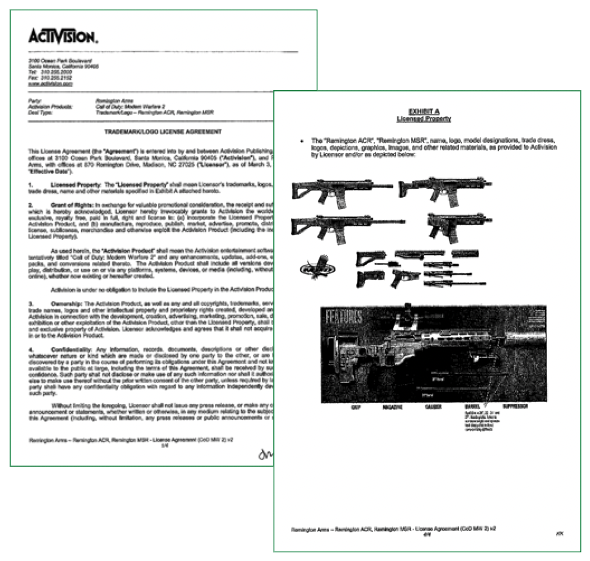Sandy Hook Promise, a non-profit gun violence prevention organization founded by several family members whose loved ones were killed during the Newtown shooting, has published a report offering new insights into the gun industry’s attempts to market firearms to children and teens, including documents provided by Remington during the discovery phase of Soto v. Bushmaster Firearms International, as discussed in earlier posts.
The new report, “UnTargeting Youth: Protecting Children from Harmful Firearm Marketing,” highlights one document — Remington’s “2011 Planning Creative Brief” — laying out the gun maker’s plan to garner sales by targeting “Millennials” and “youth” as well as traditional firearms customers. As the report notes, the memo was written when “the youngest members of the Millennial generation were between 10 and 14 years old.”
Another never-before-seen document in the report is a licensing agreement between Remington and video game developer Activision for Call of Duty: Modern Warfare 2. While only included as a small thumbnail in the report, the document gave Activision the rights to replicate two Remington firearms — the semi-auto Adaptive Combat Rifle (ACR) and bolt-action Modular Sniper Rifle (MSR) — in the first-person-shooter video game.

Remington uncovered in Soto v. Bushmaster.
According to the report, a former Remington employee “conceded that Remington ‘wanted the brand exposure’” by inserting its weapons into video games. “Although ‘Call of Duty’ products are generally rated for mature audiences, in one survey 40 percent of gamers aged 12-17 reported playing Call of Duty: Black Ops, just one game in the successful franchise.”
Using Social Media Influencers
The report also details how gun makers use social media influencers to market their products, as discussed here. The report notes that “while social media channels ban the direct sales of firearms on their platforms, they allow influencers who can be paid by the firearm industry to share posts about guns, an enormous loophole that makes the direct bans on marketing all but useless.”
These social media influencers, described in the report as “tactical enthusiasts,” “gun bunnies,” and even children, “serve as highly effective spokespeople, particularly to kids.” Many do not disclose their paid partnerships with gun companies, yet they “are pushing the same themes that run through other firearm marketing efforts. They are promoting firearms as supporting aggression, as a way to connect oneself with the military, and as a key accessory in an aspirational lifestyle filled with tough men, gorgeous women, and precocious children. These posts are truly adult content, but they are undoubtedly reaching youth, including young male teens, who are active on social media and biologically vulnerable to these messages.”
report recommendations
Sandy Hook Promise’s report builds on previous research and calls for the Federal Trade Commission (FTC) and Congress to intervene. “If the firearm industry continues to pay influencers to market to kids and the tech industry continues to turn a blind eye to their platforms being used to deceptively market firearms to children, the FTC must use its authority to protect Americans. The FTC should enforce actions against influencers that are failing to follow the law and against any companies paying them to do so. It is deceptive to fail to disclose paid partnerships, and allowing marketing on platforms used by millions of kids is an unfair practice given children’s developing brains and inability to maturely process these messages.”
If the FTC doesn’t act, “Congress needs to act to pass legislation that prohibits unfair and deceptive marketing of firearms to children and adolescents under the legal age of purchasing a firearm…These are clear opportunities for common ground and bipartisan work to protect our kids.”